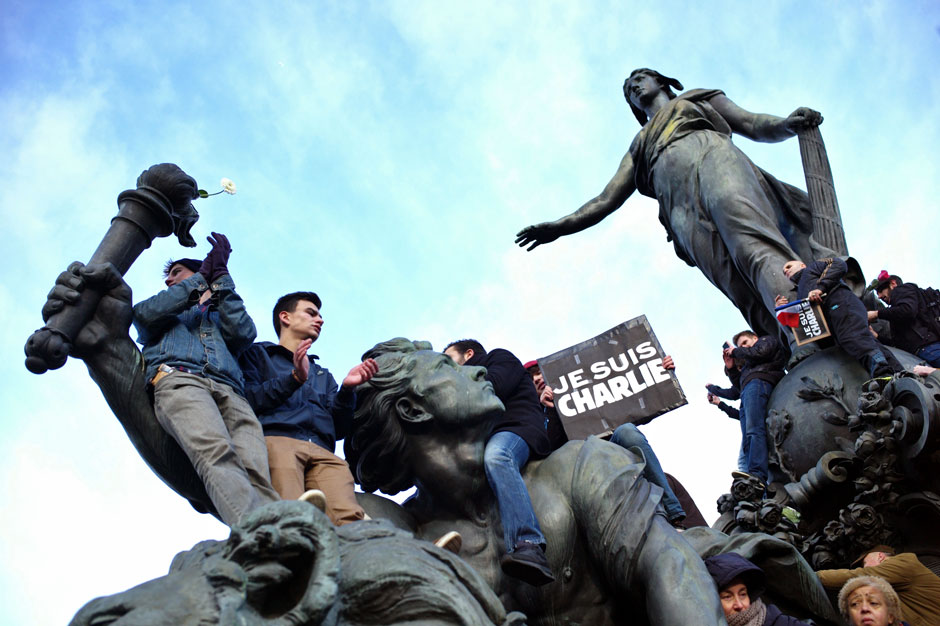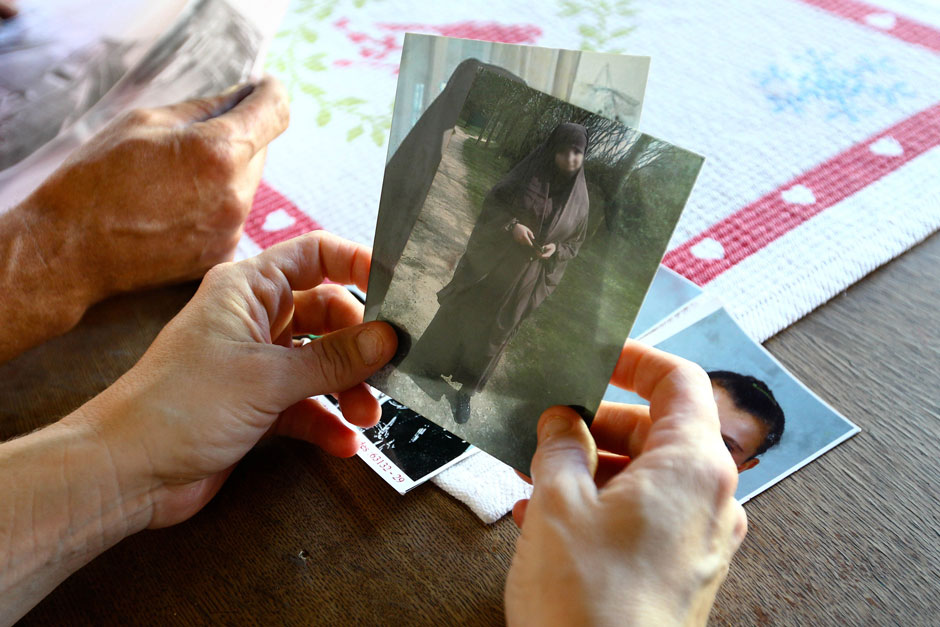Not long after the editors of the satiric paper Charlie Hebdo were massacred in their offices on the morning of January 7, people in cities across France gathered in public places to hold silent vigils for the dead. And there they remained for the next two days as the killing continued. A policewoman was assassinated the next morning, and the following day eight hostages were taken in a kosher grocery store, four of whom were eventually murdered. When it was all over President François Hollande declared a national day of mourning and called on the French to demonstrate their solidarity with the victims by marching on Sunday, January 11. Millions turned out all over the country.
But the demonstration that took place in Paris could hardly have been called a march. Between the Place de la République and Place de la Nation, and in all the surrounding neighborhoods, a million people or more milled about as best they could. Some carried signs, some waved flags, some held enormous toy pencils in comic homage to the editors of Charlie. Others carried copies of the paper or had taped one of its covers to the backs of their coats. The most common one showed Muhammad sitting with his head in his hands, weeping and saying, C’est dur d’être aimé par des cons (“It’s hard being loved by assholes”). The mood was serious but not funereal, and certainly not vengeful. The slogan from François Mitterrand’s successful presidential campaign of 1981 came to mind: La Force Tranquille. Occasionally there would be a wave of clapping and cheering, like at a soccer match, or someone would break into the Marseillaise and thousands would join in. But generally it seemed that people just wanted to be witnesses, of something and to something. As it grew dark I spotted a man standing by himself in a park, holding poles with the French and Algerian flags, whose ends he had tied together.
No one had predicted or even expected the attacks. But already one reads and hears that “all the signs were there” and that “they”—the government, the police, multicultural journalists—refused to recognize them. It is not a hard story to sell.
It begins in May when Mehdi Nemmouche—a Franco-Algerian petty criminal who had converted to radical Islamism in prison and then gone to Syria to join jihadist groups fighting there—walked into the Jewish Museum of Brussels and calmly murdered four people with an assault rifle and revolver. He had fallen off the radar of the anti-terrorist services and was only caught by chance when police did a routine inspection of the bus bringing him back to Marseille. Nemmouche had been inspired by Mohamed Merah, the terrorist who in 2012 assassinated three Muslim French soldiers in Toulouse, then massacred a teacher and three students in a Jewish school in Montauban, thirty miles away. Merah’s last victim was an eight-year-old girl, whom he turned toward the surveillance camera before shooting her in the head. He also filmed the murders with a camera attached to the front of his jacket, which inspired Nemmouche and the Paris killers to do the same.
In neither case did the French public react as strongly as it did to the January attacks, as Jewish organizations have now been quick to point out. (Israeli Prime Minister Benjamin Netanyahu, after attending Sunday’s march, tweeted a message to “all the Jews of France” that they were welcome to emigrate to Israel. To which French Prime Minister Manuel Valls responded, “France without its Jews would not be France.”) But there was general shock to discover that Merah had been celebrated as a hero on social media by some young Muslim sympathizers, and there were fears that he could inspire others.
The rapid rise of ISIS last summer brought more reasons to worry, as reports circulated about devastated families—a number of them Christian or atheists—whose children were fleeing to join the jihadist movement or al-Qaeda groups fighting in Syria and Iraq. The stories were all pretty much the same. The boys were either loners from broken families who converted via the Internet, or learned about the jihadi websites from friends and left for what they thought would be a military adventure, sometimes in groups. Four young men from a single French country village, for example, were killed in Syria in a single week in October. The girls were mainly motivated by humanitarian concerns about Syria, and once drawn in became online converts to Islam and in many cases married Islamist fighters via Skype, then left to join them. Their stories were compiled in a remarkable recent book, Ils cherchent le paradis ils ont trouvé l’enfer (They Were Looking for Paradise and Discovered Hell) by the anthropologist Dounia Bouzar, who runs a center to dissuade and reintegrate young people caught trying to reach the battle lines in Iraq or Syria. French fighters appear to make up the largest group of European jihadists in the region, and the flow continues. Le Monde reported that those who have been traced come from eighty-three of France’s ninety-five départements.
Advertisement
Then, in September, Hervé Gourdel, an experienced mountain travel guide was captured by jihadists in Algeria’s Djurdjura mountains while going to visit friends. He was marched before cameras wearing a Guantánamo-style orange uniform, made to kneel down, then was beheaded. He was the sixth such French victim over the past five years. Many such beheadings of foreigners were reported in the fall, but the real shock came with the revelation that some of the butchers themselves were also French nationals. The most dramatic case was that of Maxime Hauchard, a twenty-two-year-old convert from a small Norman village, who in November was spotted in an ISIS video showing a beheaded American aid worker, Peter Kassig.
By the week before Christmas the French public was on edge. On December 20, a Muslim convert whose Facebook page was full of radical Islamist material walked into a police station outside of Tours crying “allahu akbar,” pulled out a long knife, and stabbed three policemen, nearly killing one, whom he may have been trying to behead. He was shot and killed. The next day a Muslim man with severe psychological problems and screaming the same thing drove into a Christmas market in Dijon, killing one person and wounding a dozen more before trying, unsuccessfully, to commit suicide. The following day another mentally unstable man babbling something about the children of Chechnya did the same thing in Nantes, killing a shopper at the market and injuring many more. At roughly the same time someone fired shots into the office of a synagogue in the nineteenth arrondissement of Paris, missing the rabbi and his assistant. The first three attacks received wide, breathless press coverage, full of speculation and errors. The fourth, against a Jewish target, very little.
And so, when news broke of the Charlie Hebdo killings, the French were in a sense primed for it. It did not seem preposterous that one of the Kouachi brothers who committed them came from what is euphemistically called here a “sensitive urban zone” where radical Islamists fished for men; that they admired Mohamed Merah and Mehdi Nemmouche and wished to emulate them; that one was drawn into radical Islam in prison and both had spent time in Yemen; or that after finishing their work they would shout “Allahu akbar, we have avenged the Prophet! We killed Charlie!” Nor was it unthinkable that their friend Amedy Coulibaly, who had also embraced jihadism in prison, would attack a kosher grocery store and murder Jews in cold blood. What no one was prepared for was the fact that these young men had military weapons and flak jackets in a country with strict gun control; that their acts were loosely coordinated and that the brothers’ attack was apparently planned by al-Qaeda in Yemen; that they had been excellently trained and went about their business calmly and professionally; and that there may be many more like them lurking in French cities or on their way back from the killing fields of the Middle East.
The shock is that things are far worse than anyone had feared.




